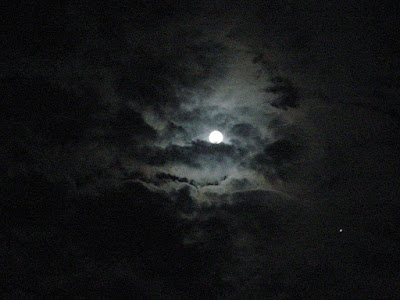1667 (Kanbun 7), 24 years old
(24)
do blossom faces make you shy? misty moon
hana no kao ni hareute shite ya oborozuki
花の顔に晴れうてしてや朧月
A humorous personification of a hazy moon. At the sight of beautiful blossoms, the moon feels too shy to show itself through the haze.The season is spring (kigo: oborozuki).
(25)
let plum trees in bloom be untouched by the wind's hand
sakarinaru ume ni sude hiku kaze mogana
盛なる梅にす手引風も哉
The poet asks the wind: "Do not blow down the ume (Japanese plum) blossoms that are in full bloom." As in classical waka poetry, there is a play on related words (engo): "sude" (an "empty hand," which combined with "hiku" means "to leave alone") contains "su," which means "vinegar," and ume are indeed very sour (suppai)! The season is spring (kigo: ume).
(26)
that spring wind: sculpting the willow's hairstyle
achikochi ya menmen sabaki yanagigami
あち東風や面々さばき柳髪
Another complicated poem: "achikochi" means "here and there," but "kochi" also means "spring wind" or "east wind". "Menmen sabaki" is difficult to translate: it means "to do something in one's own way," but "sabaku" also means "to comb (hair)". "Yanagigami" (willow hair) is a word for the long and thin branches of a willow tree, but it can also refer to the long and beautiful hair of a lady. Finally, this is an adaptation (honkadori) of a classical poem by Fujiwara no Kinto (966-1041), which includes a line about "the wind combing the branches of a willow tree". Here (as with many of Basho's early haiku) I must express my gratitude to Toshiharu Oseki, who in Basho's Haiku gives grammatical notes and explanations for all of Basho's hokku (this is from Vol. 2, in which he deals with the early, almost untranslatable hokku).The season is spring (kigo: yanagi).
(27)
snowflakes large as rice cakes twist into strands: the willow tree!
mochi-yuki wo shira-ito to nasu yanagi kana
餅雪をしら糸となす柳哉
"Mochi-yuki" are snowflakes so large that they look like rice cakes (mochi, made with glutinous rice), and "shira-ito mochi" are rice cakes made with flour in the shape of a thread or string. There are two pairs of related words here: mochi-yuki and shira-ito (mochi) on the one hand, and ito (thread) and yanagi (willow) on the other.
The season is spring (kigo: yanagi).
(28)
even amidst blossoms, my bag of poems remains shut
hana ni akanu nageki ya kochi no utabukuro
花にあかぬ嘆やこちのうたぶくろ
Basho makes fun of himself for not being able to write a single hokku about the splendor of the flowers he observes - this reminds me of his inability to write a poem about the famous Matsushima landscape in Oku no hosomichi. "Kochi," which we saw as "east wind" in an earlier poem, here is slang for "I" or "mine." "Not being able to open his bag of poems" is a joke about "not being able to find a poem inside of himself".
The season is spring (kigo: hana).
(29)
the spring wind ought to coax laughter from the blossoms
harukaze ni fukidashi warau hana mogana
春風に吹き出し笑ふ花も哉
"Fukidashi" means both "to start blowing" and "to burst out laughing". "Fuki" is also an associated word (engo) of "harukaze, spring wind."
The season is spring (kigo: hana).
(30)
as summer approaches, shield the wind's breath from toppling blossoms
natsu chikashi sono kuchi tabae hana no kaze
なつちかし其口たばへ花の風
"The mouth of the wind" refers to the opening of the wind sack carried by the wind god (Fujin) - there is a famous sculpture of the wind god with the wind sack on his shoulders at Sanjusangendo Temple in Kyoto. Covering the mouth of the wind/wind sack has a double meaning: to protect the blossoms, but also to save the wind for the hot season when it is really needed. The season is spring (kigo: hana no kaze)

